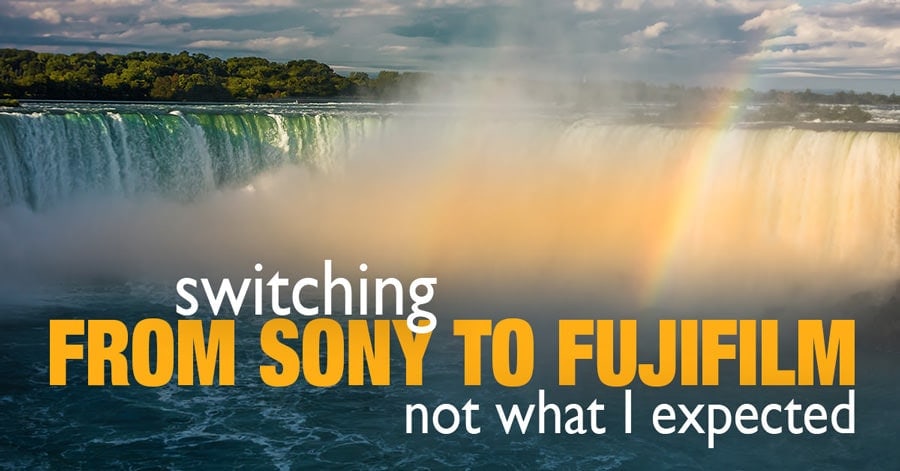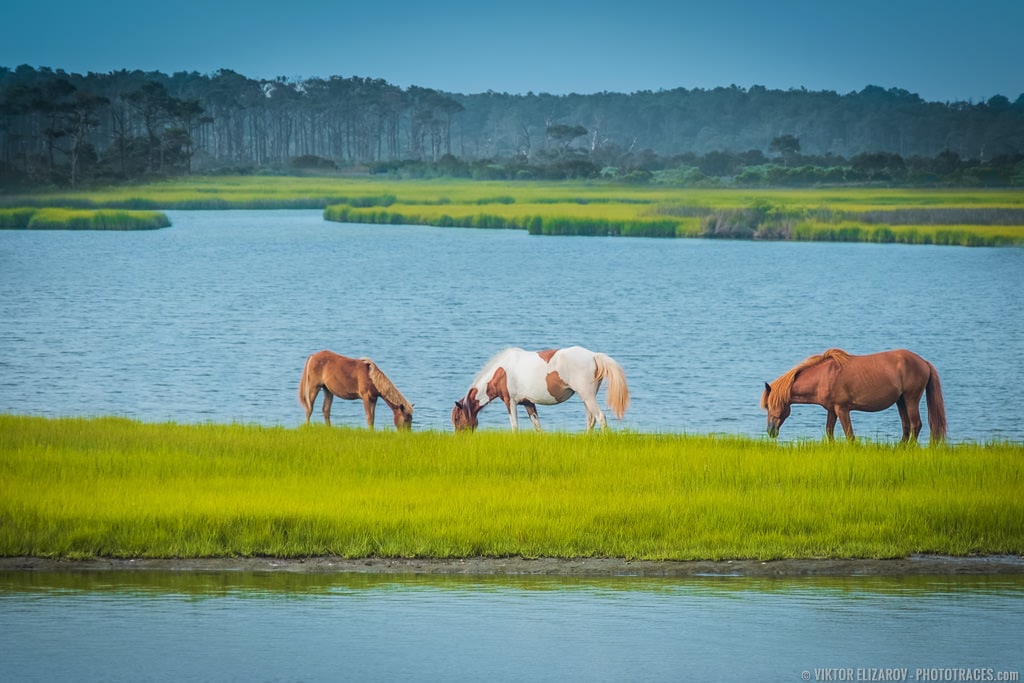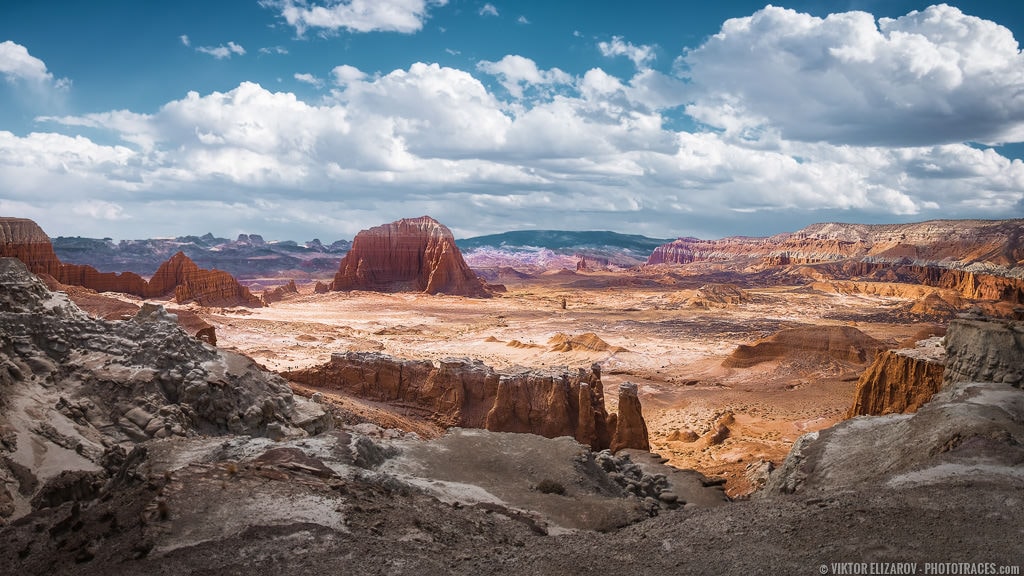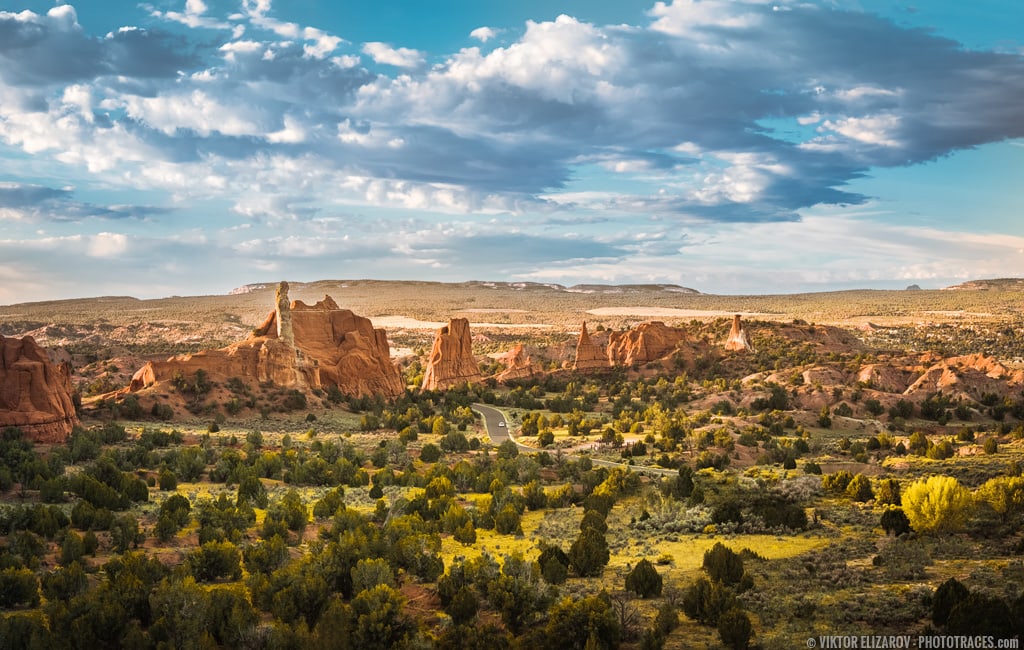It’s been a while since I switched from Sony to Fuji. At this point, I am ready to give you my reasons for the switch and how I compare Fujifilm vs Sony crop sensor cameras.

First, I must admit that Fujifilm was not what I expected. It actually turned out to be entirely the opposite of my expectations. I got interested in Fujifilm because of the need for a better user experience, but I stayed with it because of its image quality and stellar Fuji lenses.
Let me explain.
I switched from Canon to Sony four years ago; I had a very different motivation. I was not only dissatisfied with Canon but with DSLR technology in general. I was eager to explore the mirrorless realm and did not have a particular camera brand in mind. I picked Sony because of the quality of digital files it produced compared to Canon.
Sony vs Fujifilm. Reasons for Switching
As I considered the switch this time, I had only one brand in mind: Fujifilm. Here are the main reasons:
1. User Experience
When you mature as a photographer, you develop a unique photography routine and habits. You know exactly what you want to see in a camera that is closely aligned with your photography workflow. With Sony, I felt that I could not customize my photo equipment how I wanted. I hoped combining the streamlined Fuji menu system with the mechanical dials and customizable buttons would offer more flexibility.
When I decided to switch to Fujifilm, I only considered the top of the line XT2 model, but I had difficulty finding reliable reviews. Why? The reason was because of Fuji’s unique approach to firmware updates.
Since Fujifilm launched its XT2 model in August 2016, it has released three major firmware updates that extend the camera’s functionality by adding hundreds–that’s right, hundreds–of new and updated features.
By the end of 2017, most of the initial XT2 reviews were outdated because it was a very different camera.
Related: Fuji XT2 vs XT3 – Side by Side
I find Fuji’s approach to be unique and refreshing, making them more like a software startup than a consumer electronics company. It feels like a modern approach to photography when a company listens to users and makes improvements to existing cameras through software updates.
I wanted to be part of that experience.

2. Curiosity
I know plenty of fellow photographers who shoot with Fujifilm and love the Fujifilm experience. Sometimes, they praise Fuji so much that it feels like they are part of a cult-like Scientology or CrossFit. I was curious to explore the cult-like experience from the inside.
I was also intrigued to explore the completely different design of Fuji cameras with their various mechanical dials and gazillions of customizable buttons.
Also, as a photographer and educator, I thought it would be good to learn another system so I can intelligently discuss it.
3. Need for the Ultimate Travel Camera
For a long time, I wanted the ultimate travel camera setup. I craved for a combination of a compact weather sealed camera and lens.
I was also looking for a modern dual memory card functionality that would give me a completely redundant backup workflow from start to finish.
And finally, I wanted my travel camera to have a reliable and straightforward GPS tagging functionality.
Related: Top Accessories for
I could not accomplish everything with Sony.
4. Neglect By Sony
I remember a few years ago when someone from a photo community predicted that Sony would not have the bandwidth to develop both full frame and APS-C systems simultaneously. This turned out to be true. Sony neglected the APS-C systems and concentrated all its efforts on full-frame cameras and lenses. In four years, Sony has not created even one APS-C lens.
Fujifilm vs Sony. The Switch
When I switched from Canon to Sony, the most significant change that impacted my photography was the incredible dynamic range of the Sony sensors. It changed the way I shoot and edit photos.
It made me use HDR even less. And, even when it was absolutely necessary to utilize HDR, I only needed three brackets. The time of taking five to seven bracketed shots was over.
Since then, I always pay attention to the dynamic range of any camera that I evaluate and make it one of the most important paraments of my photography.
The problem with Fuji is that it uses an X-Trans sensor, and it seems that no one can accurately measure its dynamic range. This made it impossible for me to compare the dynamic range of the XT2 to my existing Sony before I made the switch.
It worried me a bit because I did not want to sacrifice the dynamic range in my new camera.
So, instead of switching right away, I decided to first test the Fuji. When a local fellow photographer was selling his practically new Fuji X-T2 body, I knew it was the perfect opportunity for me to compare it to Sony.
I bought the camera and complemented it with the Fujinon 18-135mm lens. Over the next six weeks, I used both the Sony and Fuji systems side by side.
Related: My Fujifilm Travel Photography Gear
Here is what I discovered.

The Positives of Switching from Sony to Fujifilm
1. Dynamic Range
The dynamic range of the Fuji XT2 sensor is incredible. I cannot measure it precisely to give you the exact number of stops it covers but, based on my purely empirical experience; it is better than the Sony a6000, a6300, and a6500. In six weeks, I have not used HDR, even when shooting directly into the sun. The amount of detail I can recover in highlights and shadows is staggering.
This is something I did not expect.

2. Image Quality
Currently, I have two lenses: Fujinon 10-24 and Fujinon 18-135. The combination of the Fuji XT2 and the 10-24 or 18-135 produces much cleaner and sharper images than the Sony a6000 or a65000 with a Sony 16-70 or Sony 10-18. The Fujifilm images are perfectly usable at 100% magnification. Unbelievable.
3. Fujinon Lenses
It is common knowledge that Fujifilm lenses are good, and I had a general idea of what to expect.
But, I want to concentrate on Fujinon 18-135 lens. It is not the most popular Fuji lens, but I picked it as part of my ultimate travel photography setup. It is weather sealed, and stabilized with a very useful focal length. I knew in advance that I could go on an extended trip with only that lens.
After using Fujinon exclusively for 2 weeks, I realized that pretty much all the Fujinon 18-135 reviews I read were inaccurate and misleading. Most of them concluded that it is a decent lens but you can not expect much from a super zoom lens.
I do not agree with those conclusions. I find this lens to be outstanding. The image quality is excellent and when shooting at f/8 – f/11 I hardly can tell the difference between Fujinon 18-135 and everybody’s favorite ultra wide Fujinon 10-24.
The Fujinon 18-135mm has the best Optical Stabilization I have ever experienced. I managed to shoot at focal length 135mm using shutter speed 1/10s and produce a perfectly sharp image. It is remarkable.
4. Electronic Viewfinder
The EVF is to die for. It is HUGE and bright. It contains an enormous amount of information, and you can customize it in any way you want. It has already changed the way I take photos.
I assigned the front function button to trigger the Histogram display in EVF. With the latest firmware update, it displays a combined histogram plus three more versions for each color channel. Now when I am ready to shoot, I press the AE-L button to lock the exposure; next, I activate the histogram inside of the EVF, and finally, I tweak the exposure by adjusting the exposure compensation using Front Command Dial. And I always have four histograms in EVF to evaluate my adjustments.
Love it.
5. ISO Performance
One of the shortcomings of the Fuji XT2 is considered to be not a stellar high ISO performance. But, once again, I do not entirely agree with the conclusion. I guess if you compare XT2 ISO performance to a full frame sensor camera like the Sony 7r, it might be the case, but I find the ISO performance is excellent for the APS-C camera. I was surprised that at ISO 12800, images are still usable with plenty of details.
The combination of excellent ISO performance with improved and extended Auto ISO functionality allows me to shoot in conditions I would never consider shooting before.

The Negatives of Switching from Sony to Fujifilm
1. Ergonomics
The day I received the camera and the lens I went on a day-long trip to shoot winter landscapes. After shooting for 2 hours, I realized I had cramps in my fingers.
Sony a6000 is a small camera, but it has a beefy, not very deep, but pretty wide grip, and I could comfortably carry the camera using my entire palm. But the Fuji XT2 is a bigger and heavier camera with a tiny grip, and I always had to squeeze it with my fingers putting unnecessary strain on them.
After 5 minutes of Googling, I realized the small grip was a common issue for many Fuji cameras. And of course, I found the solution fast. I ordered the thumb grip, and it almost fixed the problem.
I also bought an inexpensive L-Bracket with a metal grip.

Fujifilm XT2 Vertical Shoot Hand Grip
Now when I shoot handheld, I use a thumb grip only, and when I am on a tripod, I also attach the L-Bracket Grip.
But, I am still not entirely comfortable. I hope, over time, I will get used to it.
I am a big Back Button Focus user, and the AE-L and AF-L buttons are tiny, and it is hard to use them. I had to assign Rear Command Dial to lock the focus on a press down. It is not entirely comfortable.
2. Inconsistency with Customization
I like the Fuji XT2 design and mechanical dials, but I expected to have the ability to assign all mechanical dial functionalities to customizable function buttons. That is not the case.
For example, I can use Front Command Dial to adjust exposure compensation by setting the mechanical dial to the S option, and I like it a lot.
But, I can not assign Drive selection to a custom function button or even a Quick menu. The only way for me to change from single mode shooting to bracketing, which I do a lot, is to use a mechanical subdial under the ISO dial. I have to use my second hand to change it.
The same goes for the Metering selection; you have to use a mechanical dial and no function button or Quick Menu options.
When shooting in Aperture Priority mode, the only way to change the aperture value is to use a lens aperture ring. It is very comfortable when shooting handheld, but when on a tripod, once again, it requires a second hand. There is no way to change the aperture using the Rear Command dial.
I hope that in future updates, Fujifilm gives us the ability to assign any function to any function buttons or at least to a Quick Menu. I would love to be able to customize the XT2 so I can change any settings with one hand and without moving the eye away from EVF
3. Custom Setting
I find that one of the most useful custom configurations on any camera brand is the ability to save a group of custom settings and recall them with one click. I used it on Sony and Canon.
I was excited about Fujifilm custom settings because I knew you could save up to 7 custom configurations, plus you could give each configuration a unique name. And it is easy to recall each saved configuration from Quick Menu.
But when I started to customize it I realized the only following settings an available for memory recall:
Dynamic Range, Film Simulation, Grain Effect, White Balance, Color Sharpness, Highlight Tone, and Noise Reduction.
That’s is right, they all related to JPEG shooting. And since I only shoot RAW, the entire Custom Setting module is utterly useless to me.
I find it to be one of the most surprising shortcomings of Fujifilm Xt2 functionality.
Fujifilm vs Sony: Conclusion
As I mentioned before, the switch from Sony to Fujifilm turned out to be not what I expected at all. I got interested in Fujifilm because of the need for a better user experience and more advanced customization, but I stayed with it because of its image quality, dynamic range, and stellar lenses.
I do not complain and have no regrets. I’ve already sold all my Sony gear and will definitely stick with Fujifilm for a year at least, but I suspect it will be longer.
And I am having a blast learning the new camera system. Plus, Fujifilm keeps us on the toes with the constant firmware upgrades.
Also, it proved again there is no such thing as a perfect camera.

Fujifilm vs Sony (2019 Update)
It’s been almost 18 months since I switched from Sony to the Fujifilm camera system. I decided to give you a quick update.
First of all, I have grown even fonder of Fujifilm gear over time. I like its aesthetics, the quality of gear, and the quality of images Fujifilm produces. Plus, I like Fujifilm’s photographer-centric approach to business.
At this point, I have no plans to look for an alternative. I will stick with Fujifilm.
I still shoot with the Fujifilm X-t2. In 2018, I was very excited when Fujifilm announced the X-t3, and I was eager to upgrade. But when I checked the specs of the X-t3, I realized there was nothing for me there.
The Fujifilm X-T3 offers drastic improvements in video specs and autofocus, neither of which I care for much. The features I cared about the most—image quality dynamic range and low light performance – did not change in the X-T3 model.
I also hoped the X-T3 would introduce a bigger battery to eliminate the need to carry a pile of spare batteries along with me. This did not happen.
Fujinon 35mm f/1.4
I added a new Fujifilm lens to my collection. I purchased the Fujinon 35mm f/1.4, which acts as the “nifty fifty” on APS-C sensor cameras. The lens is one of the oldest models in the Fujifilm line and has a very old autofocus motor. The autofocus is noisy and not very fast, but the lens produces incredible images with distinctive looks.
According to Fujifilm’s chief engineer, when they designed the Fujinon 35mm f/1.4 lens, they had the option to make it optically perfect or make it distinctive and unique. They chose the latter. It is now one of my favorite lenses I have ever owned. Plus, it is tiny and incredibly light.

My working horse is the Fujinon 10-24mm f/4 wide-angle lens. I use it for most of my landscape photos. Its only weakness is its lack of weather sealing. When I am in the field in the rain, I have to switch to the Fujinon 18-135mm. This lens is weather-sealed and gives me a very useful reach of 135mm (200m full-frame equivalent).
The Fujifilm 18-135mm is almost the perfect lens for my needs, but it has one shortcoming. It is too big and heavy for long and demanding hikes. Recently, Fujifilm announced a new lens—the 16-80mm f/4 —that is smaller than the 18-135mm lens, has the best image stabilization in the industry, and is weather sealed. It has the potential to be the ultimate travel lens. I absolutely plan to check it out when it becomes available.
That is it for now. Let me know if you have any questions in the comments below. I am happy to answer any of your inquiries.
Sony vs Fujifilm (Very Last Update 2023)
It will be my last update to Sony vs Fujifilm article.
It has been exactly 5 years since my original switch from Sony to Fujifilm. And now, the switch is officially over.
Let me explain.
Over the last five years, I took my Fujifilm XT2 on a couple of dozens of trips all over the world. I captured with it many exciting photos I am really proud of. It’s been a 100% positive experience.
I got used to the camera, its controls, and the menu system. I customized XT2 to my liking and really enjoyed the experience. And I love Fuji lenses.
But not everything was perfect in paradise.
I was not crazy about Fujifilm’s direction with the XT line of cameras.
As I mentioned above, I did non upgrade to Fuji XT3 because I could not see in it anything valuable for my photography. I did not want to pay for a new camera to upgrade the video specs because I did not use XT2 for shooting videos. I have GoPro for video purposes. I decided to wait until the XT4 release.
But when Fuji released XT4, I realized that the new camera had become bigger and heavier. They had to increase the size to accommodate a bigger battery and IBIS. Plus, I despised the flip-out screen. The Fuji XT line became a hybrid camera line. And I was not crazy about it.
I decided to skip XT4 once again and stick with my old and trusted XT2 for two more years.
The plan was to wait for the next iteration of the XT camera, and if Fuji would not change its direction, to look for an alternative elsewhere.
But Fujifilm got scared to lose me as a customer and came up with the perfect travel camera the way I wanted.
The company realized the XT line was originally designed as a photography-centric camera, not a hybrid. They returned to their roots and created a true successor to XT1 and XT2 models.
First, they reduced the camera’s size, which was my favorite change. XT5 is comparable to the size of XT2, even slightly smaller. But, since they still had to fit a bigger battery and IBIS, they made it a little deeper.
Plus, over the years, I changed how I look at IBIS. Instead of functionality with limited use for landscape photography, I treat it as a potential advantage. I decided to experiment with my shooting routine. I want to decrease my tripod use and shoot more handheld, relying on IBIS for stabilization. I plan to reduce the weight I have to carry when traveling. That’s the plan. Let’s see how it goes.
The smaller form factor, return to the tilt screen, bigger battery, new sensor and processor were enough reasons for the upgrade.
The only challenge was to find the XT5 in the store. Fuji announced XT5 on November 15, but I only managed to get it on the very last day of the year, December 31. I could not get it from B&H, Adorama, or even Amazon. Instead, I found it in a small local store in Montreal. It was refreshing to buy photo gear in person again and not online.
Initially, I was not sure what to expect from 40MP new sensor; I thought it was overkill for an APS-C camera. But it turned out to be a positive change. When I switched from Sony to Fuji XT2, I was surprised that RTF files were usable even at 100% magnification. With the new 40MP sensor, RAW files are sharp and full of details even at 200% magnification. I like it a lot. Now, I do not want to go back to 26MP old sensor.
Plus, at the last moment, I decided to get a kit instead of a camera body only. Now I have a brand new lens, Fujinon 16-80mm f4, and I need to test it to see if I want to keep it.
In a couple of months, I will publish a Fujifilm X-T5 review outlining my experience with Fuji XT5.
It also means that I am sticking with Fujifilm for the foreseeable future.





